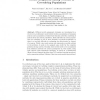Free Online Productivity Tools
i2Speak
i2Symbol
i2OCR
iTex2Img
iWeb2Print
iWeb2Shot
i2Type
iPdf2Split
iPdf2Merge
i2Bopomofo
i2Arabic
i2Style
i2Image
i2PDF
iLatex2Rtf
Sci2ools
PPSN
2004
Springer
2004
Springer
Credit Assignment Among Neurons in Co-evolving Populations
Different credit assignment strategies are investigated in a two level co-evolutionary model which involves a population of Gaussian neurons and a population of radial basis function networks consisting of neurons from the neuron population. Each individual in neuron population can contribute to one or more networks in network population, so there is a two-fold difficulty in evaluating the effectiveness (or fitness) of a neuron. Firstly, since each neuron only represents a partial solution to the problem, it needs to be assigned some credit for the complete problem solving activity. Secondly, these credits need to be accumulated from different networks the neuron participates in. This model, along with various credit assignment strategies, is tested on a classification (Heart disease diagnosis problem from UCI machine learning repository) and a regression problem (Mackey-Glass time series prediction problem).
Credit Assignment Strategies | Distributed And Parallel Computing | Neuron | Neuron Population | PPSN 2004 |
| Added | 02 Jul 2010 |
| Updated | 02 Jul 2010 |
| Type | Conference |
| Year | 2004 |
| Where | PPSN |
| Authors | Vineet R. Khare, Xin Yao, Bernhard Sendhoff |
Comments (0)

